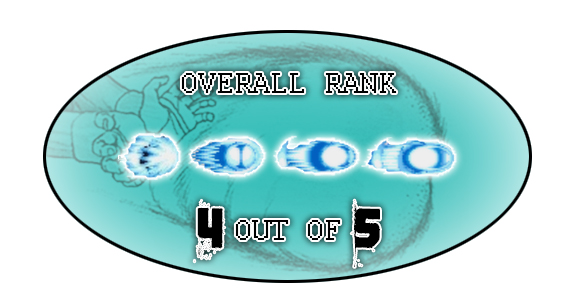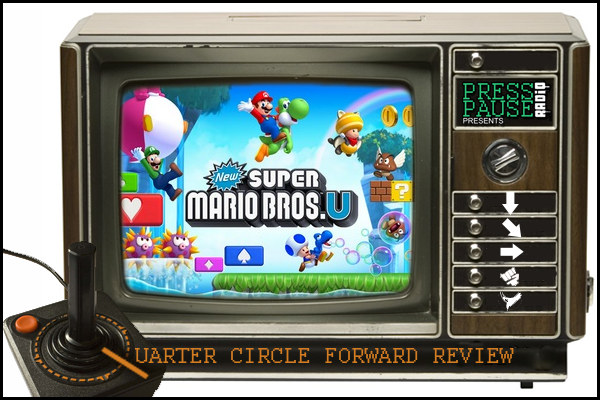
Nintendo has always had a special charm that’s undeniably inherent in each of their releases, even if some of them are starting to show their age. The “New” within the title of Nintendo’s resurgence effort to bring Mario back into the side-scrolling platformer spotlight has been looked at with some skepticism, argued to some extent even that it’s hardly “new” to begin with. With the Wii U out of the gates, we’re treated to the breakout Mario launch title; New Super Mario Bros. U, and while the “New” argument still holds some weight, this latest installment manages to defy any jaded expectations.
The red and green plumbers are tasked with the daunting objective of remaining faithful to their traditional run ‘n jump formula while finding ways to refine and reinvent key aspects surrounding it. New Super Mario Bros. U doesn’t reinvent this formula at all, but I’d be damned if I didn’t acknowledge all of the subtle yet significant touches made to refine this entry into the best of the “New” Super Mario Bros. lineup.
The Koopa Kids are at it again with their shenanigans, interrupting a nice dinner of all things. Off with them Princess Peach goes; and so your adventure begins. The first noticeable change is the seamless connection of the grand Overworld. Each world is connected to one another in the vein of Super Mario World, which may seem like an aesthetic choice that’s easily overlooked at first, but is also intricately designed to faintly hint at secret routes. Successfully finding these routes provides shortcuts that can warp players ahead to other levels out of succession, which caters to both the completionist and level racer. It makes speed runs relevant again through a spectacular motion of discovery. The levels become more organic because of this trait and you’ll find yourself bumping and rubbing against every suspicious looking wall or crouching on top of every pipe you come across in order to ensure that no stone is left unturned if it concerns a new potential route.
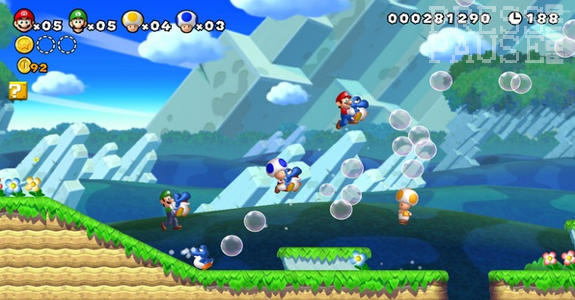
The approach towards navigation is the biggest innovation within NSMBU, but other new elements deserve a mention. These additions to the physical gameplay may not be as abundant in contrast to the manner of Super Mario Bros. to Super Mario Bros. 3, but the small additions add some key points of play that work to refresh the experience. The Baby Yoshi mechanic is unique, as it almost acts as a perk to the player when they encounter one on the map, and the little dino will remain with you until you have lost it to the chasms of a bottomless pit or any other lethal hazard. Baby Yoshis are able to be picked up and carried in 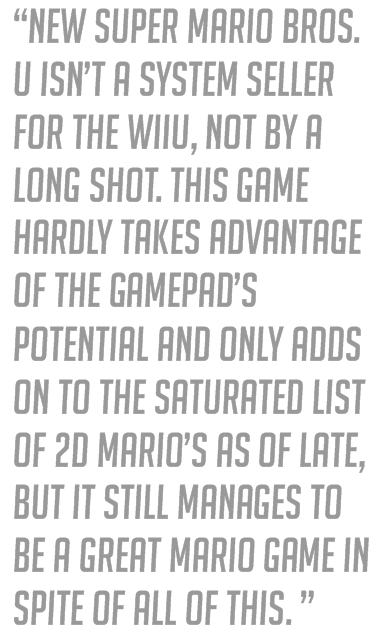 front of you, which puts them into a prime feasting position for nearly every member of the Koopa-Troopa clan unfortunate enough to be in your way, (even Boos, yeah, you read right). Beyond the endless void of their appetite, the main use for the dino-tikes are the different talents that they possess to assist in your princess-saving quest.
front of you, which puts them into a prime feasting position for nearly every member of the Koopa-Troopa clan unfortunate enough to be in your way, (even Boos, yeah, you read right). Beyond the endless void of their appetite, the main use for the dino-tikes are the different talents that they possess to assist in your princess-saving quest.
The different colors of these Baby Yoshis determine what you’ll get from their company. Propelling yourself into a floating hot-air balloon or casting bubbles from their guts in order to trap enemies and transform them into coins, Power-ups or even a 1-UP; these abilities increase your chances of success in certain levels much more than without them.
The Power-ups are mostly the same ones from NSMBWii; such as the Ice Flower, Mini-Mushroom, and trademark Fire Flower. NSMBU also introduces the Super Acorn, which transforms the Mario gang into gliding acrobats with the new Flying Squirrel suit. The mammalian getup gives the plumbers the power to glide across the air, cling onto walls temporarily without sliding down them, and the most important ability: a shock burst of motion into a singular upward stride which will then trade off with a painfully slow glide of the characters desperatly flapping their arms in order to stay afloat. The Squirrel suit doesn’t seem to add a whole lot at first as the earlier selection of stages don’t make full use of its talents, but as you progress deeper into the U-Kingdom, players actively begin keeping an eye out for these Acorns in order to traverse certain stage elements and to uncover those aforementioned secret routes or Star coin collectibles. This compensates for the shallow penguin suit we received with the last entry.
The Miiverse functionality is both incredibly novel and underutilized. Certain feats of skill performed like collecting the three star-coins within the stage all in one go or being able to clear the course without taking any damage will allow you the opportunity to leave a message that will remain in the level and track your accomplishment on your Nintendo Network ID profile on Miiverse. The closest thing that Nintendo has implemented to resemble the popular practice of achievements by completing meta-objectives within the game quickly becomes one of the most engaging dynamics in traversing through each level. Unfortunately it quickly loses its luster when the lack of variety for some of your feats becomes repetitive.
The incentive is still unique with the addition of being able to leave a personal message that you can type or even sketch akin to DS chatting, but the accomplishments alone leave little to exclaim anything profound or worthwhile after so many earned entries. This feature plays at the same communal note that the Demon/Dark Souls games did; even having the ability to distinguish which hints will reveal “spoilers” and which won’t. The only difference is that the incentive to do this was much larger in their games while it’s simply "neat" in NSMBU, and like the notes found with accomplishment will quickly lose its appeal.
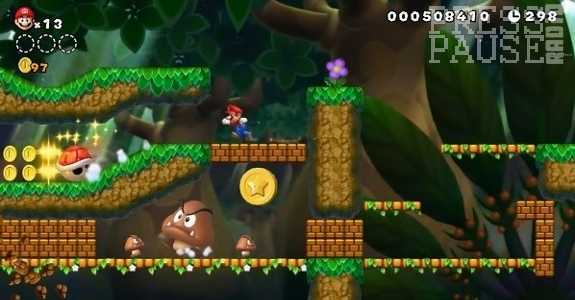
The unique aspect of multiplayer makes a strong comeback this time around with the addition of Boost Mode, a mode that puts one player at the helm of the Wii U Gamepad as an observer while other players will use the Wiimotes in the same manner or the prior title. The role of the observer is to add blocks with the tap of a finger on the gamepad’s touchscreen, which then translates to screen above. The inclusion of the Boost Mode role that allows an additional player to seamlessly drop blocks for platforms to assist their partners on the fly adds a deep co-operative gameplay dynamic that requires a level of communication and teamwork that no Mario game has ever seen before, and will be hard-pressed to top.
The act of player griefing is still a touchy issue, however, as players can still collide with one another and sabotage jumps or movement and can otherwise just be flat-out jerks to each other. Be it butt-slamming one another or initiating a malicious scoop of a player whose fate ends with a lava pit, players who enjoy that sort of thing will be pleased to know it’s still there and in full force in NSMBU (you can be a real dick, too, in Boost Mode when you “place” those blocks). Still, the most glaring flaw of this entry is the lack of online multiplayer. While the NSMBWii may have been forgiven due to online restrictions of the framework within the Wii’s hardware, such an issue doesn’t hinder the WiiU. The absence of online multiplayer yet again demonstrates how Nintendo fails when it comes to fully comprehending what online integration can mean for a game.
The visual design is a mix of old and new; gleaming rendered shapes of the prior entries alongside vistas and backdrops that are, again, reminiscent of Super Mario World with a High Definition coat of paint. This particular aesthetic was always a mixed bag given the limitations of the DS and the Wii lacking the processing power to sharpen the visual design, rendering it all a jaggy mess. NSMBU, however, gains the benefit of high definition and the result finally does this particular graphical style justice. Unfortunately the music doesn’t come anywhere close to the degree of improvement the visuals do, and it retains the same abhorrent Doo-Wop music the series started out with. The soundtrack is such a shame considering that Koji Kondo, one of the most revered video game composers in the medium, is within the ranks of Nintendo and yet players are still subjected to stagnant music that’s run its course years ago.
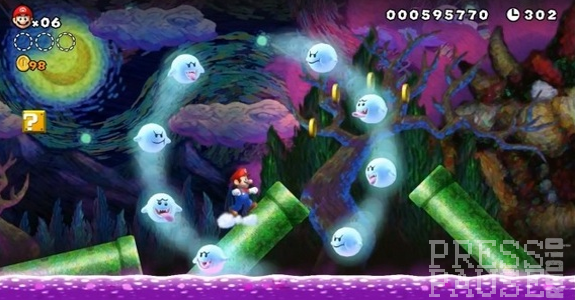
Most players, Nintendo faithful or not, were a bit cynical on whether or not they should bother with New Super Mario Bros. U. Especially after the disappointment of the entry that was released on the 3DS only a few months prior. New Super Mario Bros. U isn’t a system seller for the Wii U, not by a long shot. This game hardly takes advantage of the Gamepad’s potential and only adds to the saturated list of 2D Marios as of late, but it still manages to be a great Mario game in spite of all of this. Rest assured that if you have it in you for just one more go at saving the Princess in a side-scrolling adventure, this is the most solid title released within the “New” lineup and should be visited at the least by any platforming fan.
